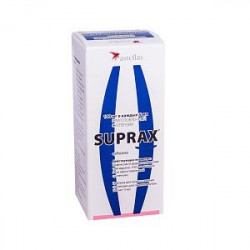



 All payments are encrypted via SSL
All payments are encrypted via SSL
 Full Refund if you haven't received your order
Full Refund if you haven't received your order
Granules for the preparation of suspensions for oral administration:
5 ml contain cefixime 100 mg;
ExcipientsSodium Benzoate; sucrose; yellow resin; strawberry flavoring;
in a bottle of dark glass 60 ml complete with a dosing spoon.
Suprax is a semi-synthetic cephalosporin antibiotic of a broad spectrum of action of the third generation for oral administration. Bactericidal effect. The mechanism of action is due to inhibition of the synthesis of the cell membrane of the pathogen. Cefixime is resistant to β-lactamase produced by most gram-positive and gram-negative bacteria.
In vitro cefixime active against gram-positive bacteria: Streptococcus agalactiae; Gram-negative bacteria: Haemophilus parainfluenzae, Proteus vulgaris, Klebsiella pneumoniae, Klebsiella oxytoca, Pasteurella multocida, Providencia spp., Salmonella spp., Shigella spp., Citrobacter amalonaticus, Citrobacter diversus, Serratia marcescens.
In vitro and in clinical practice cefixime active against gram-positive bacteria: Streptococcus pneumoniae, Streptococcus pyogenes; Gram-negative bacteria: Haemophilus influenzae, Moraxella (Branhamella) catarrhalis, Escherichia coli, Proteus mirabilis, Neisseria gonorrhoeae.
To drug are resistant Pseudomonas spp., Enterococcus (Streptococcus) serogroup D, Listeria monocytogenes, most of Staphylococcus spp. (including methicillin-resistant strains), Enterobacter spp., Bacteroides fragilis, Clostridium spp.
Infectious and inflammatory diseases caused by susceptible microorganisms: pharyngitis, tonsillitis, sinusitis; acute and chronic bronchitis; otitis media; uncomplicated urinary tract infections; uncomplicated gonorrhea.
Hypersensitivity to cephalosporins and penicillins.
Carefully: elderly age; chronic renal failure; pseudomembranous colitis (in history); children's age (up to 6 months).
Use during pregnancy is possible only when the intended benefit to the mother outweighs the potential risk to the fetus. If necessary, use during lactation should stop breastfeeding.
Suprax take inside. For adults and children over 12 years old weighing more than 50 kg, the average daily dose is 400 mg (1 time per day or 200 mg 2 times per day). The average duration of treatment is 7–10 days.
With uncomplicated gonorrhea - 400 mg once a day. Children under the age of 12 are prescribed as a suspension at a dose of 8 mg / kg once or in 2 divided doses (4 mg / kg every 12 hours). For children aged 6 months to 1 year, the daily dose of the suspension is 2.5–4 ml, at the age of 2–4 years, 5 ml, at the age of 5–11 years, 6–10 ml.
For diseases caused by Streptococcus pyogenes, The course of treatment is at least 10 days.
In case of impaired renal function, the dose is established depending on the serum creatinine clearance indicator: with a creatinine Cl of 21–60 ml / min or in patients on hemodialysis, the daily dose should be reduced by 25%. With Cl creatinine less than or equal to 20 ml / min or in patients on peritoneal dialysis, the daily dose should be reduced by 2 times.
The method of preparation of the suspension: flip the bottle and shake the powder.Add 40 ml of boiled water cooled to room temperature in 2 stages and shake after each addition to form a homogeneous suspension. After that, it is necessary to allow the suspension to settle for 5 minutes to ensure complete dissolution of the powder. Before use, the finished suspension should be shaken.
Allergic reactions: pruritus, urticaria, skin hyperemia, eosinophilia, fever, erythema multiforme exudative, toxic epidermal necrolysis, anaphylactic shock.
From the digestive system: dry mouth, anorexia, nausea, vomiting, diarrhea, flatulence, abdominal pain, dysbacteriosis, abnormal liver function (increased activity of hepatic transaminases, alkaline phosphatase, hyperbilirubinemia, jaundice), gastrointestinal candidiasis; rarely - stomatitis, glossitis, pseudomembranous enterocolitis.
From the side of blood-forming organs: leukopenia, neutropenia, thrombocytopenia, hemolytic anemia.
Urogenital: interstitial nephritis.
From the nervous system:dizziness, headache.
The tubular secretion blockers (allopurinol, diuretics) delay the excretion of cefixime by the kidneys, which can lead to an increase in drug concentration in the blood plasma.
Cefixime reduces the prothrombin index, enhances the effect of indirect anticoagulants.
Antacids containing Magnesium or aluminum hydroxide, slow down the absorption of cefixime.
In a dark place, out of reach of children, at a temperature not higher than 25 ° C.
